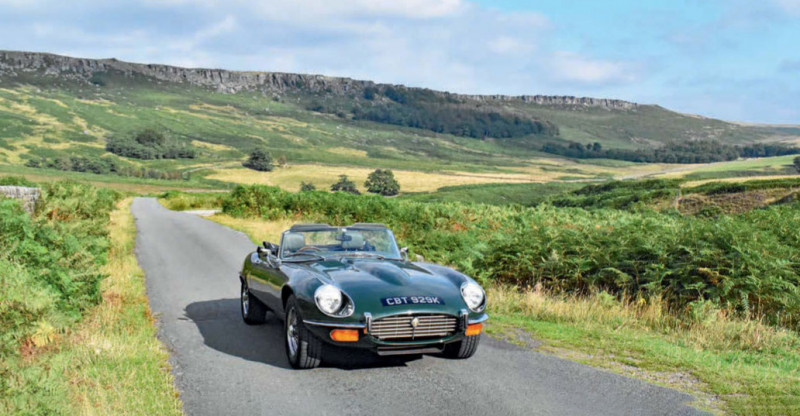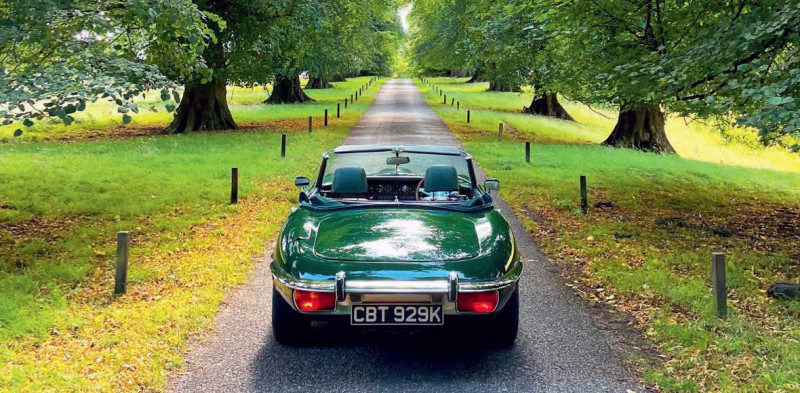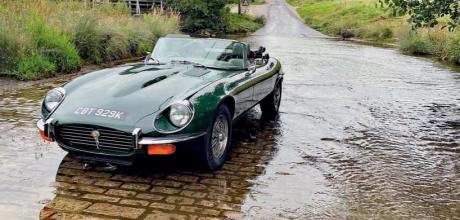Running report 1971 Jaguar E-type V12
Peter introduces his E-type in this, the first of a series of running reports. Definitely not a project car – but we’ll see how that turns out…
RUNNING REPORTV12 E TYPE
Peter Simpson (yes, again!) reveals his latest potential folly
For the last few years, I have adopted the principle of owning a 'floating classic', whereby I aim to change my car every couple of years, trading up or down (in age) to a different classic Jaguar. Upon retirement this seemed like a thrilling prospect, choosing to occupy my time by continuing a lifelong passion for scenic touring, boosted by the eureka realisation that to do so in the company of a classic Jaguar would intensify the experience. I did consider other marques but just couldn't find anything else offering the sustained character of a Jaguar through the ages, although the trickiest part was deciding which one to buy. Hang that I thought, I’ll have them all, just one at a time as my garage is small and my finances only slightly above embarrassing.

The first classic I chose was a 1963 Mk2. The tribulations of owning this serially troublesome car (see Classic Jaguar February/March 2022) should have advised me to abandon the plan from day one, but I'm not one to give up, even in the face of common sense.
The next Jaguar was a complete change, succinctly demonstrating the extraordinary variety of Jaguar heritage available, moving forward twenty-five years to a Series 3 XJ12 Sovereign. Smooth, quiet, palatial and actually more frugal than the Mk2, this was a superb gentleman's conveyance in tip-top condition. There were no mechanical follies with this car and when the time came (well, an offer I couldn’t refuse), it was a traumatic farewell, softened by the car resettling at a home that would cherish its near-concours condition, something that was threatened by my high-mileage lifestyle. We now arrive at the present day and classic Jaguar number three. My choice was partly determined by photogenic attributes, through requiring foreground impact for the scenic backdrops to feature in a touring guidebook to Britain that I am presently compiling.

I therefore decided an E-type would be just the ticket. I should make it clear that any E-type is beyond my budget so the pension pot was going to take a severe bashing, although in theory it will be replenished in a couple of years when this globetrotting photographic model is sold!
The XJ12 had seduced me with its refined power delivery, thus a V12 E-type in convertible form narrowly beat a Series 2 fixed-head as the preferred choice. I needed an E-type ready for the road so a project was not considered, although after my experience with the Mk2 I was painfully aware that even a carefully researched acquisition can throw many spanners in the works. Should I be concerned that the editor has invited me to provide regular updates on my life with the E-type? He is obviously confident in my ability to make a calamitous purchase!
As a mechanical numpty I steered clear of a purely private buy and settled on a car that was sold under the auspices of E-type specialist Butlin Classic Cars in Derbyshire, who had themselves undertaken a major restoration of the car around a dozen years ago. With the depreciation of a new restoration depleted, yet the sound basis ostensibly remaining, I took the plunge. I had looked at other cars and none were exactly to my ideal specification, including this one, but I figured that a few extra pounds to make it so would be a mere drop in the purchase price ocean. In general, the car is a beauty, especially if you like green — from the British Racing Green livery and forest green roof to a high-quality bespoke interior fashioned from tasteful green leather and deep pile carpet. Even the seat belts are green…
I am minded to name the car Kermit, although whether due to the colour or because I prove to be a muppet for buying it remains to be seen. A persuasive selling point was the professionally crafted wood veneer dashboard, which for me lifted the interior immensely. Few would not regard the sight through the windscreen of that outstretched, voluptuous bonnet as amongst the world’s most appealing views, although (in my opinion) the styling exuberance is less evident within the standard car.
Nevertheless, I did mention there were drawbacks to my choice and the downside to this particular E-type is that it appears the previous owner craved noise and power, quite at odds with the gentleman’s club cabin. The carburettors had been converted from the standard Stromberg fitment to SU’s, something I approved of, except that they had been fitted with shiny trumpet air filters, which look stunning but add much to induction noise, whilst affording dubious power enhancement. A very impressive big bore, shouty exhaust system had been commissioned, which bestowed upon the car the howl of a potent racer that for me would require ear defenders above 50mph. Another unwelcome intrusion I discovered upon quietening the exhaust was a whining differential. Early V12s were fitted with a 3.31 ratio, which I find rather energetic for cultured cruising, so I am taking the opportunity to change it for the longer legged 3.07 ratio as fitted to later cars.
A further issue is the roof: E-type roofs were a comprehensively inept design from the start but this one has been indelicately bent out of shape to the point where a bulge in the frame prevents it from seating neatly and makes fitting the tonneau impossible. If Quasimodo drove an E-type, this example would serve him well. To add insult, I had booked the car for its first public showing at Blenheim’s exclusive Salon Privé, at which we headed a line of gorgeously presented examples to celebrate the E-type’s 60th anniversary. If there had been an award for the most ill-fitting hood, we’d have won it hands down.
Upon first collection I chose not to drive straight home and polish my new possession but to introduce Kermit to his future life on the road by embarking on a 600-mile tour taking in the Peak District, the Fens and the aforementioned Blenheim Palace. The car had not been driven for well over two years, so the garage undertook some recommissioning, renewing all fluids and flushing the fuel tank, along with standard service items. Naturally my prolonged shakedown uncovered a few niggles to extend the list, but it also revealed one more irksome headache (literally) to solve. Before purchase I test drove the car on a couple of occasions for half an hour, which proved to be just not quite sufficient for, at thirty-one minutes plus, I began to detect exhaust fumes invading the cabin. They were especially noticeable when the windows were open, which for an E-type in most seasons, they are. The cause is proving to be bewildering to diagnose. The internet is not awash with woes from similarly red-eyed owners and other than a direct leak the only general consensus is a recirculation of gases from the tail pipes. True enough the quad fantail was barely poking out beyond the back panel thus was duly extended. In the engine compartment the heater ducting was resealed and a slight oil leak from the cam cover resolved with a new gasket. This work produced an improvement but only a marginal one.
It is at times like these that I envy those amongst you that have the ability and facilities to undertake your own analysis and repair, because I have now owned the car for six months and spent most of those waiting to fit the car back into Butlin’s busy schedule. The majority of the tasks were factored in and mechanically achievable, but the gas-chamber interior remains the puzzle. A possible contributor to the fumy conundrum is the trumpet air filter arrangement that had been fitted, which has the potential to exhale vapour to be subsequently drawn into the cabin. It’s just a theory but, as attractive as they look, I will be reverting to the standard air boxes and will let you know the outcome.
It was difficult not to become smitten on the first test drive
The pronounced hump in the roof lends Kermit the appearance of a mutant frog.
The trumpet air filters are visually appealing but are they the cause of the smelly cabin? The E-type is soon pressed into service as a supermodel
Below: Peter’s daughter deflects attention from the loosely draped tonneau at Blenheim’s prestigious Salon Privé. Undeniably beautiful but has Peter been dropped in deep water?
Kermit is stripped of his roof and rear underpinnings. But what is the significance of the ‘P.S.’ — is it merely the authors initials or ‘Prepared for Surgery’? Wood veneer adds a touch of decadence to the dashboard architecture


